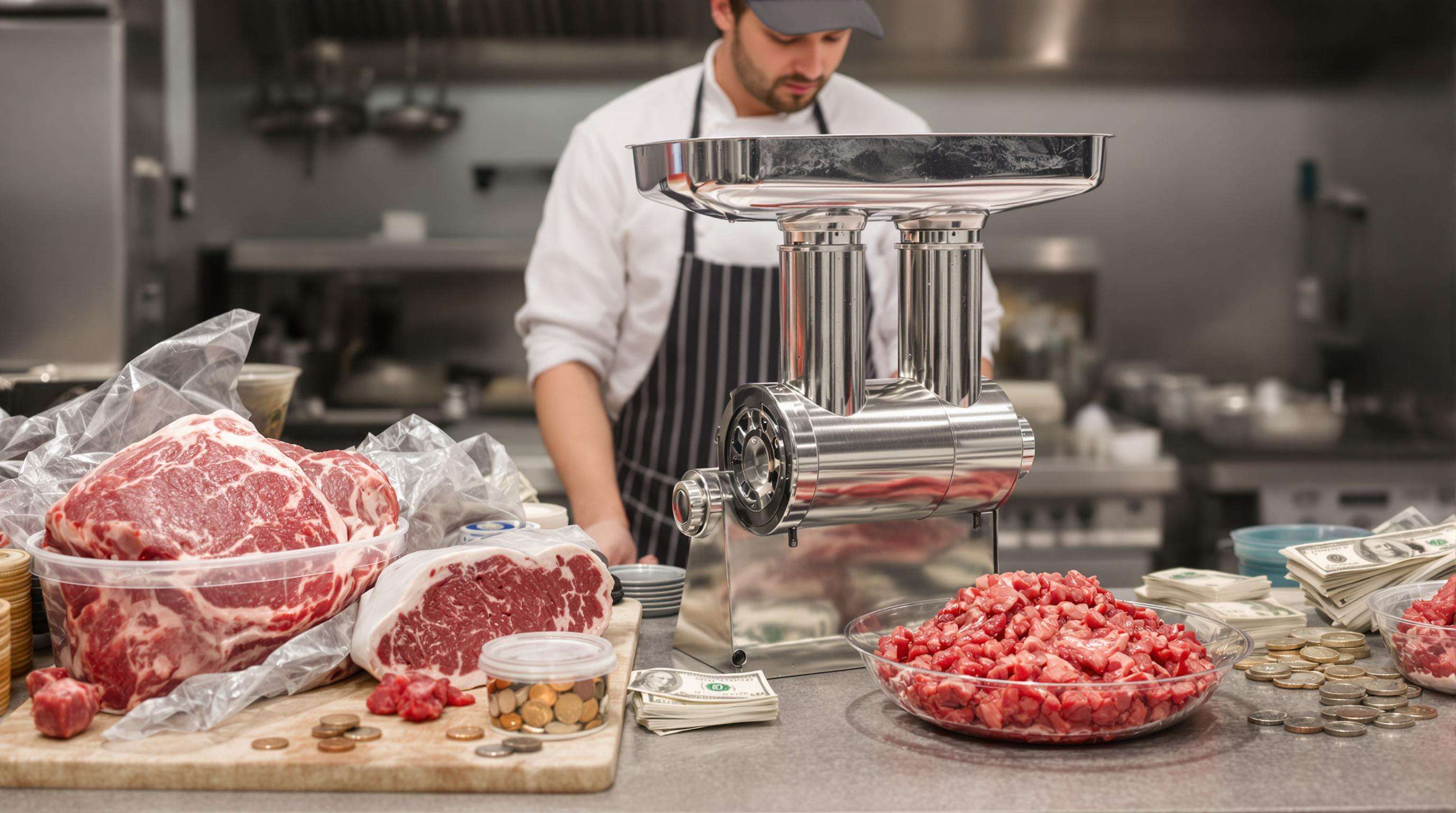More and more people dining out these days are looking for real, quality ingredients in their food. A recent survey showed that about three quarters of restaurant chefs have noticed customers asking for custom meat mixes lately according to the National Restaurant Association report from last year. When restaurants invest in good meat grinders, they can really stand out from the competition. They make special burgers, homemade sausages, and even recreate regional dishes using whole cuts of meat rather than buying pre-prepared stuff. Why is this happening? Well, folks just aren't trusting those factory packaged meats anymore.
Stainless steel grinders in commercial kitchens give chefs better control over meat textures because they keep things cool enough during processing so fat doesn't smear all over everything. When restaurants grind their own meat instead of buying it pre-ground, the natural fibers stay intact, resulting in juicier burgers on the grill. Chefs can also tweak fat content as needed - some places go for an 80/20 chuck blend rather than the usual 70/30 mix suppliers offer. Plus, there's no oxidation issue when meat isn't sitting around in bulk storage for days. Ground beef actually starts losing flavor pretty quickly after it's processed, maybe about 15% within just one day. All this attention to detail cuts down on wasted product and lets restaurants create their own signature items, like thin cuts of ribeye for Korean bulgogi or lamb kofta mixed with whatever spices the cook prefers at the moment.
Restaurants that grind their own meat can pocket anywhere between seven and twelve dollars for every pound when they buy whole primal cuts instead of already ground options. Grinding on site gets rid of all that wasted trim that comes with pre-cut portions, so most chefs manage to use around ninety five to ninety eight percent of each cut of meat. Take a typical place that works through about two hundred pounds of beef each week. Over the course of a year, they'd probably recover thirty to forty extra pounds worth of good meat that would have gone straight into the trash otherwise. That kind of waste reduction makes a real difference in bottom line numbers for busy commercial kitchens.

Looking at data from around 140 restaurants in 2024 showed something interesting - those using commercial meat grinders actually cut down their protein costs between 27% and 32% over just twelve months. How did they manage this? Well, first there were the bulk buying savings when purchasing whole cuts instead of pre-ground meat. Whole cuts came out to about $3.79 per pound versus nearly $5.25 for already ground stuff. Then there was no need to pay extra for suppliers to grind the meat, which saved another $0.35 to $0.60 per pound. Plus, fresh ground meat lasted longer on shelves too, staying good for 3 to 4 extra days compared to what comes pre-packaged. Most surprising might be how fast these machines paid for themselves. Nearly all operators who invested in stainless steel models saw their investment recouped within less than a year and a half according to the survey results.
While commercial grinders require an initial $1,200–$4,800 investment, operators save $18,000–$32,000 annually in reduced meat costs at moderate usage levels. High-torque models (1.5–3 HP) processing 50–80 lbs/hour minimize labor expenses through faster throughput. Maintenance costs remain low ($120–$250/year) for stainless steel models with self-sharpening blades and dishwasher-safe components.
For most commercial kitchens where food safety matters most, stainless steel meat grinders have pretty much taken over as the go-to option. The material's smooth surface doesn't let bacteria hang around and makes cleaning much easier too something really important when dealing with lots of different meats all day long. Regular metals just don't hold up like stainless does when faced with things like lemon juice, aggressive wash downs, or those intense steam cleaners they use in restaurants. That kind of toughness helps meet those FDA rules about equipment needing to stay clean and not break down over time. According to recent studies published last year in Food Safety Journal, restaurants that switched to stainless steel grinding equipment saw their risk of microbes dropping by roughly 40 percent compared to what they had before.
Regular maintenance turns a meat grinder from something dangerous into something dependable. Taking apart the machine every day for thorough cleaning of those blades, plates, and augers stops fat from building up, which is one of the main reasons ground meat goes bad. Lubricating the gearboxes once a week and checking the motor monthly helps keep the equipment running longer and performing consistently over time. Restaurants that follow a clean as they go approach tend to have about 60 percent fewer problems with contamination linked to their equipment. When combined with proper training for staff on storing meat at safe temps below 40 degrees Fahrenheit or 4 degrees Celsius, this creates a much safer kitchen environment overall. According to data from the National Restaurant Association back in 2022, commercial kitchens that check their procedures every three months experience around 28% extended service life for their grinders plus about 35% reduction in wasted food.
Commercial meat grinders give chefs a real edge when it comes to creating unique menu items through custom meat blends. According to a recent survey from the National Restaurant Association, around two thirds of chefs say having control over the grinding process is essential for making those signature burgers with just the right fat content, like that popular 80/20 beef chuck mix, or experimental sausages combining flavors such as chorizo and brisket. The possibilities don't stop there either. Many restaurants now offer specialized ethnic dishes too - think traditional Middle Eastern kibbeh made with lamb and bulgur wheat, delicate Asian dumplings filled with finely ground pork, or even gluten free chicken merguez sausages catering to customers watching what they eat. These options let restaurants stand out while meeting diverse customer preferences.
A family owned eatery in the Midwest saw their appetizer sales jump nearly half in just six months when they started making six different artisan sausages right on site with their own stainless steel grinders. They grind fresh Berkshire pork every day from local farms and mix up their seasonings fresh too. This switch cut down what they paid for pre-made sausages by around $22 per pound. Customers love the difference and give them consistently high marks for authenticity in online reviews, often hitting 4.8 stars or better.
Restaurants processing over 800 pounds of meat weekly require grinders with capacities exceeding 1,000 lbs/hour to maintain workflow efficiency. Smaller operations (200–400 lbs/week) can opt for 250–450 lbs/hour models to avoid overspending on unused power. Overestimating needs leads to unnecessary energy costs, while undersized equipment strains staff during peak hours.
Grinders equipped with 1.5 horsepower motors can handle around 14 to 18 pounds of meat each minute, making them essential equipment for restaurants needing to grind whole cuts down into burger patties fast during those busy lunch hours. The smaller models with only 0.75 to 1 horsepower tend to overheat pretty quickly when working with tougher meats that have lots of connective tissue, think brisket for example. For commercial kitchens where speed matters most, going with gear driven motors instead of belt systems makes sense since these maintain better torque even when grinding through tough cuts all day long. Most experienced kitchen staff will tell you this difference is night and day when things get hectic in the back of house.
Stainless steel meat grinder machinery reduces bacterial growth risks by 62% compared to plastic components (Food Safety Journal 2024). Full metal construction withstands 8–10 years of daily sanitization cycles without corrosion, whereas aluminum housings degrade after 3–4 years. High-grade steel blades retain sharpness through 12,000+ lbs of meat, ensuring uniform texture across batches.


Copyright © 2024 Zhaoqing Tengsheng Machinery Co., Ltd all rights reserved - Privacy policy